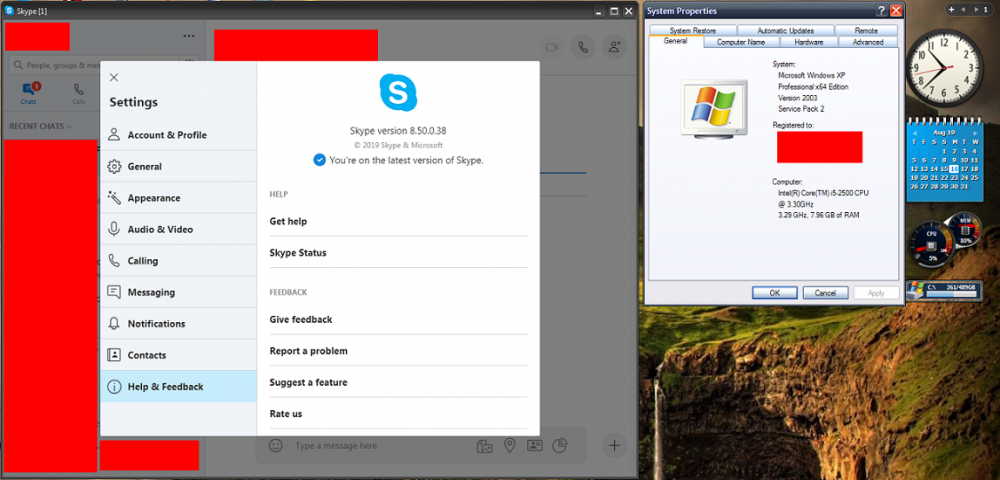Leaderboard
Popular Content
Showing content with the highest reputation on 08/16/2019 in Posts
-
This thread is just for XP we have seen "out in the wild" or on the internet, not our own personal systems. We have a thread for that kind of thing here: Which I will be posting in soon once I get my notebooks sorted out.1 point
-
1 point
-
Run Windows PAE patch for enough memory - run Virtual virtual with OS which is supporting Skype within or Unity window mode (Vmware only) its behaves as normal Window.1 point
-
The best you can hope for is to use Application Verifier on the desktop client to fake Windows 7 once it starts to block XP/Vista. However, they may take the opportunity to recompile it with dependencies on DX 11.1 (Windows 8 and up, partially backported to 7) or other Windows 7-specific functions. You may still have a glimmer of hope in the former case, if these DX 11.1-specific libraries can be copied over to Vista with no dependency issues, as that's what happened to later iterations of DX9 with so-called XP-exclusive components; they work in Windows 2000 even without the extended kernel. All I can say is, keep your copy of dependency walker handy.1 point
-
There is no such thing as "Linux boot menu". The boot menu is what the bootmanager loads, very likely you have GRUB2 as bootmanager/bootloader. And of course you are not dual booting Linux and Windows 10, you decide if you want to remain generically vague (i.e. Linux and Windows) or if you want to detail which Linux distro AND version it is besides Windows 10 LTSB. More generically, if you actually have GRUB2 as bootmanager, you should be actually preoccupied of the Linux updates/upgrades, as most times they do run an "update-grub" command that actually rebuilds (or rather attempts to rebuild) the GRUB2 configuration file (which is usually grub.cfg). If you prefer, the grub.cfg menu (which is very likely what you see when you boot) in GRUB2 is not "static" and is generated (at install time and re-generated with the grub-update command) starting from a set of "base" files. Depending on the EXACT way the GRUB2 has been installed and on the contents of these files, and on the EXACT distro/versions of the Linux distro you are using, this (stupid) auto-magic regeneration may work or it may not. Most of the times it just works, of course, but when it doesn't you'd better have a plan B. Having a backup of the "current" grub.cfg is of course obligatory, but you will need to get familiar with the (complex) mechanism of grub.cfg (stupid) auto-generation and also IMHO get familiar with a few needed GRUB2 commands, as if for whatever reasons the grub.cfg is not found or it has been automagically updated and the update didn't work you will find yourself incapable of booting and stuck at a grub-rescue> prompt. Here is an exceptionally good tutorial: https://www.dedoimedo.com/computers/grub-2.html You want to make sure that either there is a directory corresponding to your Window install or that the provisions for it are inside the 40_custom one, but you should learn also how to boot both the Windows and the Linux from a plain grub-rescue> prompt via a sequence of commands, and - adviced - have handy a copy of the SuperGrubDisk: https://www.supergrubdisk.org/ https://www.supergrubdisk.org/super-grub2-disk/ just in case. jaclaz1 point
-
... And I'm so tired reading that same ol' mantra there: As if they (third party software developers) would give one nickel whether someone's setup is secure or not; what is the underlying truth inside this PR talk is that Microsoft themselves make it gradually impossible for third party software developers to target older OSes with their (M$'s) updated Windows SDKs! ... and it always comes down to that! Win7 will soon reach End of Extended Support, hence it'll also be "outdated and unsupported by Microsoft", with no more "security patches"; what is their stance on Win7? Security reasons my... behind!1 point
-
Dedicated to fans of windows XP/2003 running on moderm (Acpi 2.0) PC Main purpose of patcher is help with eliminate/fixing Acpi 2.0 opcodes and 64-bit fields/regions/math without touching bios. Patch modify acpi tables every time when os start, it change current state of acpi tables in RAM memory (Bios load tables from flash chips to ram). Patcher works only with CSM (compatibility) mode, it will never works in UEFI boot mode. Using: 1) All custom files must named in old "8.3" DOS way ! 2) Create folder "ACPI_PAT" at root of you boot drive where installed target OS, this folder is place for storing all custom files (except bootloader) 3) Replace original bootloader (NTLDR for windows 2000/2003/XP, BOOTMGR for Vista/7/8/10, GRLDR for grub4dos) with patcher, original bootloader save as "xpldr" in ACPI_PAT folder 4) Place acpi_pat.img at ACPI_PAT folder 5) Place main configuration file ACPI_PAT.CFG: [DSDT] reload.bin bnum_fix.dif iotr_fix.dif,201904 test1.dif test2.hex [SSDT1] ; patch1 ;SSDT_FI1.HEX [SSDT3] ; patch 3 ;SSDT_FI3.HEX [SSDT*] # universal ssdt patch #SSDT_UNI.HEX [FACS] ;APIC_FIX.HEX [DSDT] [SSDT] - name of acpi table, only 4 chars !!! [SSDT3] - patch 3rd ssdt table, order of the ssdt table is determined by its position in the rsdt/xsdt tables [SSDT*] - special name to modify all ssdt tables ; patch1 - comments start with ";" or "#" reload.bin - BIN override table from binary file bnum_fix.dif - DIF is text format for GNU Patch iotr_fix.dif,201904 - DIF format with forcing iasl compiler version test2.hex - HEX is text format of "Find&Replace" hex strings 6) Order of applying patches is up-to-down, better to place first .bin patch, then .dif or .hex 7) Example of .hex format: ; comment 706869637320/706869637420 ;without spaces 70 68 69 63 73 20 / 70 68 69 63 74 20 ;with spaces, more readable 70 68 69 63 73 20 - hex string to find 70 68 69 63 74 20 - hex string to replace you can increase/decrease count of replaced bytes, size of table will be changed dynamicaly 8) Patcher supplied with 3 versions of iasl compiler/decompiler: IA201604.EXE IA201612.EXE IA201904.EXE These versions are equivalent of 20160422, 20161222, 20190405 at acpica.org Default version for processing dsdt/ssdt tables maded before 2016-12-31 is IA201612.EXE, for later dates is IA201904.EXE. You can also use your own version (DOS VERSION, compile yourself from acpica sources), name it "iaXXXX.exe" and place inside EXE.7z archive on floppy image. 9) Examples of .dif format: Fix BNUM Decompiling Bug: --- DSDT.dsl +++ DSDT.dsl @@ -1,1 +1,0 @@ - External (BNUM, UnknownObj) Fix Resource conflicting on Windows XP for Gigabyte H110-HD2 bioses: --- DSDT.dsl +++ DSDT.dsl @@ -1,36 +1,13 @@ AMI1 = ITA1 /* \ITA1 */ AMA1 = ITA1 /* \ITA1 */ AMI2 = ITA2 /* \ITA2 */ AMA2 = ITA2 /* \ITA2 */ AMI3 = ITA3 /* \ITA3 */ AMA3 = ITA3 /* \ITA3 */ - If ((ITS0 == One)) - { - ConcatenateResTemplate (Local0, BUF0, Local1) - Local0 = Local1 - } - - If ((ITS1 == One)) - { - ConcatenateResTemplate (Local0, BUF1, Local1) - Local0 = Local1 - } - - If ((ITS2 == One)) - { - ConcatenateResTemplate (Local0, BUF2, Local1) - Local0 = Local1 - } - - If ((ITS3 == One)) - { - ConcatenateResTemplate (Local0, BUF3, Local1) - Local0 = Local1 - } Return (Local0) } } } Scope (_SB.PCI0.LPCB) Patches generated by invoking (you can change/remove "-u6" option) Diff : diff -u6 --strip-trailing-cr OLD.DSL NEW.DSL > my_patch.dif Keep in mind that different versions of the compiler generate different versions of the ASL text. So context of .dif file is in most cases bound to specific version of the compiler 10) If using .dif patches, need additional file external.txt this is text format for using iasl.exe decompiler "-fe" option like this: External (AL6F, MethodObj, 0) External (HLVT, MethodObj, 0) External (P0L6, MethodObj, 0) External (P1L6, MethodObj, 0) External (P2L6, MethodObj, 0) External (PS0X, MethodObj, 0) External (PS2X, MethodObj, 0) External (PS3X, MethodObj, 0) External (_SB_.PCI0.GFX0.IUEH, MethodObj, 1) External (_SB_.PCI0.GFX0.GSCI, MethodObj, 0) External (_SB_.PCI0.PAUD.PUAM, MethodObj, 0) External (_SB_.PCI0.PEG0.HPME, MethodObj, 0) External (_SB_.PCI0.PEG1.HPME, MethodObj, 0) External (_SB_.PCI0.PEG2.HPME, MethodObj, 0) External (_SB_.PCI0.XHC_.DUAM, MethodObj, 0) External (_SB_.PCI0.XHC_.RHUB.INIR, MethodObj, 0) External (_SB_.PCI0.SAT0.SDSM, MethodObj, 4) External (MDBG, MethodObj, 1) External (_SB_.TPM_.PTS_, MethodObj, 1) 11) If using .dif patches, may be need additional file ignores.txt this is text format for filter iasl.exe decompiler errors, example of file: [BNUM] Namespace lookup failure, AE_ALREADY_EXISTS Many kabylake/coffelake bioses created with uncorrected asl code around BNUM fileld, when you decompile it, you will get "ACPI Error: [BNUM] Namespace lookup failure, AE_ALREADY_EXISTS (20161222/dswload-390)" error. With ignores.txt possible to filter/ignore these errors 12) When using .bin files, take care about override DSDT/SSDT tables, "template" from BIOS image is bad choice for such files. Bios patch some parts inside table before deploying to OS (bios usualy set absolute adresses). In this case run OS and save tables from runned state. Regards & Copyrights: FreeDOS by FreeDOS Project SHSURDRV by Jason Hood 7zdec by Igor Pavlov/7-zip.org Move by Joe Cosentino/Imre Leber XCOPY by Rene Ableidinger/Eric Auer GRUB4DOS by GRUB4DOS Developers FAT module for grub4dos by chenall.net Volkov Commander by Vsevolod V. Volkov NTFS for DOS by Avira GmbH iASL by Intel/Acpica DJGPP by DJ Delorie CWSDPMI by CW Sandmann inih by benhoyt Internals & Hacks: - acpi_pat.img is bootable 2.88MB FAT12 floppy image with FreeDOS & utils - When pressing any SHIFT key when starting, Patcher will go to debug mode, it will stop loading OS and run shell - Patcher replace original bootloader with grub4dos, when all job is done, patcher run grub4dos.exe for loading original loader - Patcher reserve 2Mb of RAM for storing acpi tables (Windows will report -2Mb available memory) - Before decompiling any table, all ssdt and dsdt tables stored at disk and used as external files "iasl -e ssdt1 ssdt 2 ... " History: v1 - Initial (Beta) Download Binaries https://github.com/MovAX0xDEAD/ACPI-Patcher/releases Download Sources https://github.com/MovAX0xDEAD/ACPI-Patcher1 point
-
1 point
-
Try adding a HOSTS file entry redirecting freegames.zone.com to the IP for mpgame5.games.msn.com1 point
-
Well, I tried taking a poke with wireshark... all I really can tell you is that XP checkers tries to connect to freegames.zone.com which no longer exists. on windoze 7 it connects to mpgame5.games.msn.com, which still indeed exists. I suppose one could redirect the old checkers to the new server, maybe. I have no clue how to do that though.1 point







